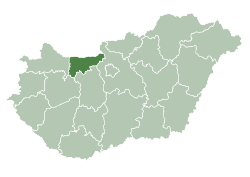Nyergesújfalu
| Nyergesújfalu | ||
|---|---|---|
 | ||
| ||
 Nyergesújfalu Location of Nyergesújfalu | ||
| Coordinates: 47°45′24″N 18°32′56″E / 47.75678°N 18.54875°ECoordinates: 47°45′24″N 18°32′56″E / 47.75678°N 18.54875°E | ||
| Country |
| |
| County | Komárom-Esztergom | |
| Area | ||
| • Total | 39.51 km2 (15.25 sq mi) | |
| Population (2004) | ||
| • Total | 7,649 | |
| • Density | 193.59/km2 (501.4/sq mi) | |
| Time zone | CET (UTC+1) | |
| • Summer (DST) | CEST (UTC+2) | |
| Postal code | 2536 | |
| Area code(s) | 33 | |
Nyergesújfalu is a town in Komárom-Esztergom county, Hungary.

The city, located near the river Danube, is an ancient site of habitation. As it was located on the Crumerum, a major Roman trade and military route, the late Romans built a fort here, to help protect the northern border of their empire.
European travelers noted the ruins, for instance, the travel writer Richard Pococke in the 18th century wrote about it. "We saw the ruins of the fort, several Roman bricks and elsewhere foundations that seemed to be Roman."[1]
The struggle for freedom in the region in the later 18th century resulted in the destruction of most of the fort, and not even the stones were visible more than a century later.
In the 20th century, the earthwork fort was rediscovered through aerial photography. Some archeological excavations have been done, which have established the original size of the fort and other details. It has become a destination for tourists and hikers; the latter take advantage of hills and trails in the region. Nyergesújfalu became a city officially in 1989.
The city's baroque-style church was built in the 18th century, when the Empress Maria Theresa granted land to the founders. Next to the church is the Salesian secondary school, founded by a religious order. Attila József, a noted 20th-century poet, studied here for a short time.
The city is associated with the noted 20th-century painter Károly Kernstok (1873–1940), who inherited a house in Nyergesújfalu and lived here for several years. He was the center of an artistic community in Budapest known as The Eight (Nyolcak) (1909-1918), who created the modernist movement in Hungarian art.[2]
International relations
Twin towns — Sister cities
Nyergesújfalu is twinned with:
References
- ↑ Richard Pococke, A Description of the East, and some other countries, in 1745, 2.2. S. 246th
- ↑ "Hungarian Hunt from Paris to Nagybánya, 1900-1914", Art Knowledge News, Hungarian National Museum, accessed 15 Sep 2010
External links
- Street map (Hungarian)
- "Nyergesújfalu", Tourist guide webpage (Hungarian)

